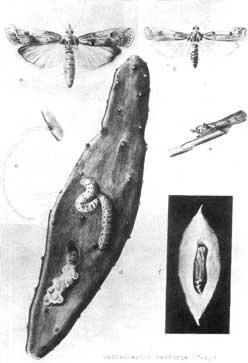Famous Creation Scientists
Interview with John Mann*, M.B.E.
Originally published in Creation 5, no 2 (October 1982): 13-17.
Most people today have no idea how bad the actual situation was.
Creation magazine: In 1969, John, you were awarded the M.B.E. by the Queen for the major part you played in the development of a biological solution to the cactus problem. Most people today have no idea how bad the actual situation was. What was it really like?

Dr John Mann: Well—the cactus invasion of Australia was probably history’s greatest recorded invasion of a country by a plant weed in any part of the world. A single, yellow flowering prickly pear was brought to Australia in 1839. By 1914 it had covered 60 million acres so densely, that it was impossible to do anything of value with the land. Families were driven off their blocks. They had attacked it with everything they had, and any special machinery or chemicals that they could invent.
Where was this?
It was in the good grazing, dairying and grain growing country in Queensland. In fact, to try and solve the problem the Government was offering people blocks of land on the condition that they could maintain a 2m (6ft) wide strip free of prickly pear around their boundaries. But this proved virtually impossible. Men broke their hearts over it because it was growing up behind them as fast as they were getting rid of it. They were in absolute despair.
How was this problem solved?
Well, our actual concept was, and still is, that since the plant in its native country generally doesn’t increase to pest proportions, it must be controlled by either organisms or conditions. So in 1913 researchers were appointed to go around the world to each place where cactus grew to see if there were any creatures that could be used for the likely destruction of cactus in Australia. They actually came back bringing with them some Cactoblastis cactorum which is the insect that did the spectacular work eventually, but they could not get them to breed.
Was this idea of insect control an original idea, unique to Australia? Had anything like that ever been done before?
Yes. In 1902 some insects had been imported from Mexico into Hawaii for the control of lantana, but this was only on a small scale. In 1914 a few insects found by a Mr A. Kobele in Mexico were introduced from Hawaii to Australia for lantana control, however it was the success of our campaign against the prickly pear which has given the impetus to later efforts in entomological control.
Did this suggestion of biological balance have any evolutionary concept behind it?
Not that I have ever heard about.
One of the chief roles you played in this area was being the person who actually got the Cactoblastis to breed in Australia. Was this a problem?
Well, I’d been breeding insects since I was 15, so no, there weren’t really many difficulties with Cactoblastis, although we were working under very spartan conditions. All we had was an old wooden building with wooden floors, lino, and one antique telephone. The techniques we had to devise were necessary because there weren’t any push-button methods in those days. I had to run an electric light cable from the main house down to the quarantine cages. I then put whatever number of electric light bulbs inside the insect cages that I estimated would give the warmth that they required to breed. As long as I kept them properly warm, they bred quite easily. People working with the sophisticated glasshouses and quarantine insectaries today, probably cannot conceive the trouble we had.
Were any safeguards necessary?
Oh yes. Once we started getting Cactoblastis eggs under quarantine conditions, we bred them in untold millions. It was necessary to test them on all sorts of plants to prove they would eat cactus and nothing else.
How long did this take before you knew it would work?
It was obvious within 12 months that we had a winner, the more discerning men on the land saw it too. All those abandoned or empty pear leases were suddenly ‘acquired.’
Do you remember any humorous events in the research program?
To be honest, the problem was so urgent that we were too dead serious about the job to have anything funny to say about it. Skeptical landholders would come and look in our cages and make caustic remarks about whether a couple of insects were going to do anything good. They poked all sorts of fun at us, even in print, but those men lived to regret the day that they didn’t own several thousand acres more of the prickly pear country we cleaned up.
Since that time, you have received much recognition for your work apart from the M.B.E. What else resulted from it?
Many things I guess. I was appointed Entomologist to the Government Department of Lands and made a Fellow of the Royal Zoological Society. The Entomological Society of N.S.W. made me a Fellow and I served on many government committees amongst other things.
But isn’t it also true that you had your work published by the Smithsonian Institute, were made a life member of the Entomological Society of Queensland and appointed as State representative on the Australian Weeds Committee, becoming eventually chairman of the Noxious Weeds Committee, a member of the Agricultural Chemicals Distribution Committee and a member of the Interdepartmental Committee for Woody Plant Control and had a genus in your honor—amongst other things.
Yes—amongst other things.
Have you addressed many science conferences since your success with Prickly Pear?
Yes, I have given many lectures on the work of biological control at science conferences, to almost every local government authority, many grazier and primary producers organizations, and on ABC radio.
John, when you retired in 1970 you were the Director of the Alan Fletcher Research Station, in charge of scientists doing research on insect and biological control, but you don’t have a university degree.
No, it was quite humorous really. When this was announced at my farewell dinner, I could see the intrigued look on the face of some of my scientific colleagues. One professor leaned over to me and said, ‘Well it never showed.’
In the 1930s what was the influence of the concept of evolution on society in Australia?
The concept of evolution at that time was not as universal as it is now. There were lots of debates about it, a lot of questions asked and being answered. In the 1920s I used to get copies of the magazine put out by the Victoria Institute in England. They were men of high degree and they wrote against evolution. Their magazine influenced me greatly.

prickly pear cactus; pupa and adult moth
Were there any Australian men of science who influenced you?
Yes, one man who influenced me was the Professor of Anatomy at the University of Adelaide. He wrote the Progress Prize Memorial Lecture, ‘The Ancestry of Man.’ He wrote about the discovery of an exceedingly early fossil anthropoid in America. This fossil animal was named ‘Hesperopithecus.’ Not only was it named but its complete form, both male and female, were shown as a whole page illustration in an English illustrated Weekly, as part of an article on ‘The Early Humanoid in America’, by Professor Elliot Smith. But the anatomy professor pointed out the only evidence on which this was based, consisted of a single water-worn molar tooth, and that there were other learned authorities of the day such as Dr Smith Woodward, had suggested that it was the tooth of a bear. When I read that in 1923, I thought to myself, ‘Well, evolutionary theory appears to have been built upon 99% imagination and 1% fossils’ so I maintained that as a Christian I would believe in the Bible until somebody could come up with any definite proof that men had evolved from animals.
Did the concept of evolution worry you at all?
No it did not! It had no practical effect on my work.
But surely people had already begun to produce evolutionary family trees for the insects, which must have affected your work.
They had, but they were so practically useless that in my publications I made no reference to them. One gentleman had built up a key for flies. It was a fine looking tree. However after he had sent it to the Linnaean Society in Sydney for publication, he found more insects which altered his whole concept, so he sent them a telegram and told them not to publish his key until further notice. Finally he almost turned it upside down with his next key. So I said to myself, ‘Well I believe God; and I believe the Bible; and these men are not producing anything concrete that would make me disbelieve. Until they do I am just going to go on as I am.’
Has there been any time in your life when you really considered yourself as an evolutionist of any sort?
No, I have really never felt that way. Although when I got deeper into scientific work, I did think about the possibility that God used evolution and I went along for a time with that in the back of my mind … In my work with the flies I thought that theistic evolution was a possible answer to the theories that were put forward by some of my colleagues. But in later years I threw that overboard because I couldn’t see that it was consistent with the Bible. At one stage I accepted the Gap Theory (as it became known later) but as I advanced further in my work, not only as an entomologist but as a Christian, I couldn’t see that this could be tenable either, so I rejected it as well.
So you rejected evolution for both scientific and Biblical reasons?
Yes, to my thinking, it wouldn’t fit either way.
Did your schooling influence you in any way about creation?
Well one man did. He taught us astronomy. He had a model which showed the movements of the sun and the moon and certain stars and planets. I remember distinctly one day he stopped his machine and said, ‘Boys never let anyone tell you that these things happen of their own accord. There is a Supreme Being who guides these things in the way they go.’ I have never forgotten that, even though it is over 65 years ago.
When you look at the relationship you discovered between cactus and the Cactoblastis, do you see it as an example of a system created by God?
Yes, I certainly believe it is. When God created organisms He created their food too. If they are deprived of that specific food they die. Our specific tests on Cactoblastis showed that. The list of plants that we tried to get Cactoblastis to eat was absolutely enormous, and I would say that 85% of the plants that we had to test were almost a waste of time. Firstly because cactaceae as a group of plants are quite separate from most other groups. It was fairly safe to say that insects feeding on cactus would not eat any other type of plant and secondly, we fairly well knew that the insects wouldn’t be able to live on most of them, simply because the Cactoblastis was a gregarious internal borer. To begin to test it on wheat and oats and things like that was simply ridiculous, but we had to do it, just to prove it was safe to use them. Our results showed without a doubt that these insects had a group of plants which they could live on and nothing else. And that’s usually what is found right throughout the insect kingdom. Organisms keep to one group of plants for their feeding.
Didn’t they attack any other plants, even when they were starving?
They did crawl over some and they made a few small marks where you could see that they had made an attempt to feed on such things as potatoes and melons, and tomatoes, etc., but they couldn’t live on them. They never even began to breed on them. To me that was overwhelming evidence that they had a particular group of plants to live on and would not live on any others. We also found they were confined to certain types of cacti. There are quite a lot of groups of cactus that they will not feed on.
Throughout your life you have given talks on God as Creator and the importance of creation, particularly using your butterfly collection. Why have you done this?
Well, a long time ago I took a stand that I believed in Creation and so whenever I spoke to a meeting of people, Christians or non-Christians, I often brought up the subject of Creation and the contrasting philosophy of evolution. I would tell them exactly where I stood. At the conclusion of one meeting, a chap came to me and said, ‘Look I’m glad you said that about evolution and creation because you are the only person I have heard publicly say that sort of thing.’
Are you pleased then to see the various creation science movements throughout the world, and one very much on your home front here in Australia?
Oh, yes very pleased indeed. When I saw Dr Carl Wieland’s advertisement about his Creation Science Society in South Australia, I wrote to him. I have a copy of his first magazine here [Ed. note: this was the first Creation Ex Nihilo ever produced—June, 1978], the one he told me he had typed out himself and stapled together. I wrote to him and I joined, because I was so delighted to think there were people of position who still believed in the Word of God.
How do you personally view the effect of the increase in evolutionary thought?
Devastating! Young people in schools are being taught it as a straight-out fact. It is not a fact. It is a tragedy. People who are brought up as evolutionists, cannot be brought up to believe in God.
*Now deceased. Return to top.
Recommended Resources

Answers in Genesis is an apologetics ministry, dedicated to helping Christians defend their faith and proclaim the good news of Jesus Christ.
- Customer Service 800.778.3390
- © 2024 Answers in Genesis





